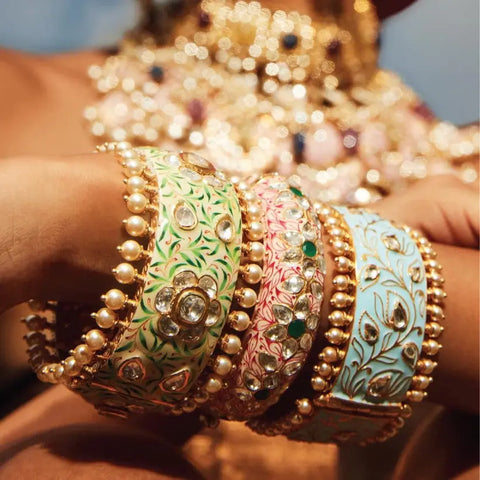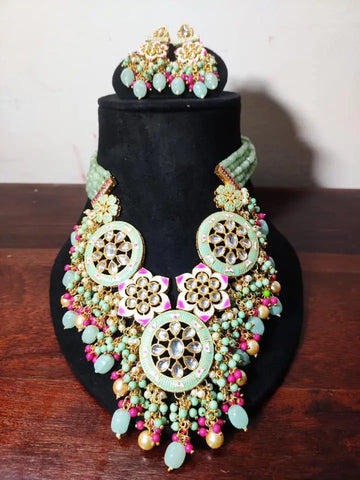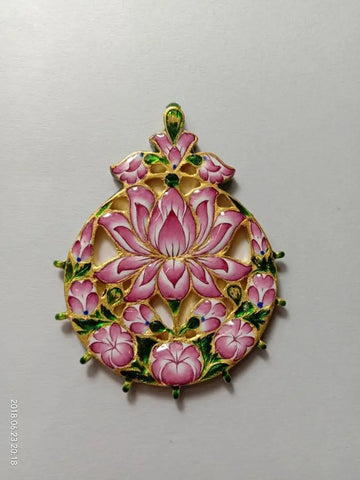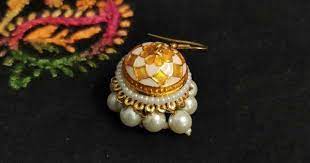Introducing Meenakari Art:
Meenakari, also known as Minakari, is a well known process of coloring and painting the top surfaces or bases of ceramics, metals and other such materials, through a method called “enameling”. This method originated in Iran, particularly, Safavid Iran, and has since been widely and commercially practiced in India, Afghanistan and even Pakistan.
This art form usually encompasses the formation of intricate designs and geometric shapes, and is known to be used for adorning many display ornaments and even jewelry.

(image credit:- wikipedia)
Details of Meenakari Art:
History of Meenakari:
The word can be broken down into two halves and seen as “mina” and “kari”. Mina is a variation of the word “minu” which is known to mean heaven, or paradise, while “kari” means to do, or to place something on another surface, or something else. Together, the word means to place paradise, or something resembling it, onto an object,
The history of enameling can be traced back to the period of Iranian history, close to around the 15th century, and the Moghuls introduced it to the Indian subcontinent, which has since perfected the technique and the designs that are made onto these surfaces. Raja Man Singh of Amber invited skilled artisans of this craft from the Mughal Palaces, situated in Lahore, to Jaipur, this initiating this art in the state of Rajasthan.
The craft was known to reach its peak in both popularity and use during the 18th and 19th centuries, and along the time it entered the 20th century, the Iranian artists that specialize in this craft were invited to several other regions to train their local artisans and craftsmen.
The artisans that perform this art form are famously known as “meenakars”.
Types of Meenakari:
The art mainly involves covering mental objects or ceramic tiles with coloured enamels. The most dominating colors in this scheme are Green, Red and White, and the metals that are covered and used are known as “chitras”.
The enameling process can be done either on the entire surface or on some chosen portions of the surface, for example, an entire pendant or locket can be covered by enamel, or a pair of bangles could be covered with some 3D prints of elephants, or birds. There are also further processes of adorning the art with precious stones, like emeralds or rubies.
Some types of Meenakari can include, Ek Rang Khula Mina, Panch Rang Mina, Gulabi Mina, Bandh Mina Khaka and Stone Carving.
Ek Rang Khula uses only a single color of transparent enamel and the engraved area is known to be filled with a single enamel, leaving gold coloured outlines that are made to expose the surroundings of figural details and intricate designs.

(image credit:- twitter)
Panch Rang Mina involves an enamel that uses 5 colors, namely Safed, which is opaque white, Fakhtai which is opaque light blue, Faktha, a dove color, Khula Nila a dark blue, and Khula Sabz, a green.

(image credit:- facebook)
The name Gulabi Mina is derived from the fact that pink enamel is used for the surfaces. It is widely used and prevalent in Varanasi, and the transparent pink is used to paint on an opaque white background. The single transparent enamel is used to fill around the ground and spaces surrounding opaque figures, and the colors provide a high contrast and highlight the designs.

(image credit:- pinterest)
Bandh Mina Khaka involves a method that uses opaque cartouche outlines, and the transparent colors are surrounded by opaque enamel cartouche.

(image credit:- Authindia)
And lastly, the Stone carving and enameling art form, represents Meenakari, that is sometimes combined with Kundans that make the articles a combination of enameling and stone carving.

(image credit:- handycraft world)
Process of making Meenakari:
The first step to this art form is the formation and engraving of the designs by the “gharias' 'by making some dips or depressions onto the Chitras metals. Post the designing, the enamellers use different colors to apply to the engraved designs, and these colors are applied with the help of special paint brushes used solely for this purpose.
The base is initially covered with a white or pink enamel, after which different colors, or colors of the artisan's choice are applied depending on the hardness of the surface. 5 rounds of separate enamel applications are done, and the object is then heated to enhance the color, and make it look more rich. After the heating, the object is polished and clean to give it a finished and fresh look, and hand burnishes are used to cover the exposed metal.

(image credit:- handycraft)
Meenakari Products:
Meenakri art can be used to design many varieties of objects, ranging from pen holders, to jewelry and ornaments. The metals used for this are typically silver, gold and copper, although in more recents times, silver and copper are used more often. Some of these articles may include sets of bowls, serving dishes, vases, containers, frames and even some display ornaments.
References:
https://www.gktoday.in/topic/meenakari-art-in-india/
blogs you might also like
Bandhani saree: the most celebrated attire from the land of Gujarat
Famous handicrafts of India from 29 States and UTs
How to accessorize your saree: Jewelery, Bags and Foorwear
 Verified Purchase
Verified Purchase

































Leave a comment (all fields required)